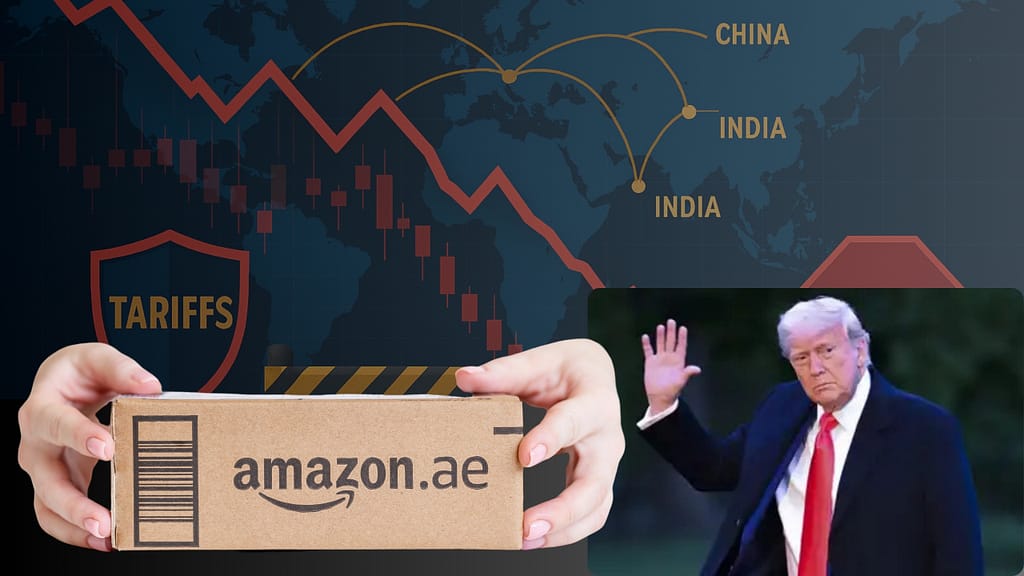It's not Confirmed Yet Amazon Headquarters Shift!
Amazon has made a big decision to move its global headquarters outside the United States, a response to President Trump's tariffs that signals a major change in how the company operates and raises questions about the future of American business.
Don't Forget to Listen Deep Dive By Our Experts on Topic, We advise to read the full Blog Post to understand context before diving into Audio deep dive.
According to a recent report from Punch Bowl News, Amazon is taking serious steps to deal with the impact of these tariffs. The company plans to show the extra costs caused by these tariffs on certain products, which has led to a strong reaction from the White House.
This post looks at what Amazon’s move means and the larger economic picture surrounding this unprecedented change.
The Tariff Landscape
President Trump has been quite vocal about his trade policies, promoting what he calls a patriotic trade revolution. This has resulted in hefty tariffs on a variety of imports, from Chinese electronics to European pharmaceuticals.
One significant change was the end of the Deminimus rule, which used to allow low-value imports to enter the U.S. without duties. This rule was vital for many third-party sellers on Amazon who depended on importing affordable goods.
The Impact of Amazon headquarters shift
With tariffs reaching as high as 145% depending on where products came from, Amazon started to lose its competitive edge. Projections suggested the company could face a staggering loss of over $13 billion in profits over the next three years if things stayed the same. To tackle this issue, Amazon launched “Project Silver Compass,” looking for a new country to call home for its global headquarters.
The Relocation Decision
Amazon’s leadership considered several countries based on factors like low tariffs, friendly tax policies, political stability, and good infrastructure. The final contenders included Singapore, Ireland, Canada, and the United Arab Emirates (UAE). Ultimately, the UAE’s offer of a 10-year tax exemption, along with other perks, made it a top choice.
Secret Negotiations
Behind the scenes, Amazon was quietly negotiating with officials from these countries to secure tax deals and data security guarantees. These discussions became more urgent as tensions grew in the U.S. over Amazon’s plans to display tariff-related costs on product pages, which didn’t sit well with the Trump administration.
The Fallout from the Announcement
On May 6, 2025, Amazon officially announced its decision to relocate its global headquarters overseas. The immediate economic impact was noticeable: Amazon’s stock dropped by 5% initially but later bounced back as analysts recognized the long-term benefits of lower taxes and tariff-free trade.
However, the local economy in Seattle took a hit, with thousands of employees facing tough relocation choices and small businesses that relied on Amazon struggling to stay afloat.
A New Era for Amazon
As Amazon began moving its executive teams to Dubai and setting up its data operations in Abu Dhabi, it was becoming more “borderless” and shifting away from its American roots. This change has prompted other major companies, like Apple and Tesla, to rethink their operations in light of the shifting trade landscape.
Implications for the U.S. Economy
Amazon’s move is more than just a business strategy; it marks a significant shift in the global business environment. The U.S. government’s approach to trade has created opportunities that other countries are eager to seize.
Places like Singapore, Dubai, and Dublin are now positioning themselves as attractive options for multinational companies.
The Response from Washington
Following Amazon’s announcement, backlash in the U.S. has been growing. Senators are calling for investigations, labor unions are accusing Amazon of betrayal, and consumer groups are pushing for federal action to prevent other companies from making similar moves.
Yet, the reality is that Amazon has already made its choice, raising important questions about what it means to be an American company in today’s global economy.
Primary Beneficiary Countries
The UAE is stepping up as a top choice, thanks to its 10-year zero-tax offer and a partnership with Amazon.ae aimed at bringing 100,000 businesses on board by 2026. Ireland and Singapore are also strong contenders with their low corporate tax rates (12.5% and 17%, respectively) and solid tech infrastructure.
Canada is positioning itself as a strategic alternative because of its closeness to U.S. markets and recent incentives for tech companies, making it a great option for keeping North American operations.
Ripple Effects on Corporate America
In 2024, there was a noticeable uptick in U.S. companies relocating, with 96 headquarters moves announced. Many of these companies are eyeing states like Texas, Florida, and Tennessee for their favorable tax situations.
If Amazon decides to move, it could pave the way for other companies to consider offshore relocations, especially multinationals dealing with tariffs. Companies like Apple and Tesla, which are also facing supply chain challenges, might rethink their U.S. commitments if Amazon shows that it can thrive abroad.
Consumer Pricing Dynamics
Even though Amazon decided not to display the 145% tariff costs on its platform, the logistics changes from relocating could still impact prices. Setting up new fulfillment centers in tariff-free areas might lower import costs for international customers but could make U.S. consumers more dependent on pricier domestic suppliers.
The partnership with the UAE, which focuses on helping small and medium-sized enterprises grow, suggests that Amazon might prioritize expanding its global marketplace over keeping U.S. prices low, especially for goods made in China that are affected by tariffs.
Long-Term Global Trade Shifts
If Amazon does relocate, it could speed up the trend of separating corporate nationality from where companies operate. The UAE’s $10 billion investment in trade infrastructure planned for 2025 puts it in a strong position to compete with Singapore and Ireland as neutral hubs for multinational companies.
This shift might lead to a more fragmented global trade landscape, where companies take advantage of host nations’ trade agreements to navigate the U.S.-China tensions. Over time, this could lessen American influence in setting international trade standards as businesses increasingly align with countries that offer more flexible regulations.
Walmart, Apple & Ross Spark Retail MELTDOWN – Collapse Fears!
Reshaping the U.S. Tech Industry and Employment Landscape
If Amazon moves its headquarters, it could worsen existing workforce challenges in the U.S. tech sector. Between 2020 and 2024, Amazon cut its workforce in Seattle by 10,000 while expanding in Bellevue, which has already shaken up Seattle’s commercial real estate market.
Vacancy rates in Seattle hit 12.4% in the first quarter of 2024, compared to 6.8% in Bellevue. A complete international move could amplify these issues, especially since Amazon has been a major player in attracting talent—accounting for 23% of Seattle’s tech job growth from 2015 to 2020.
The return-to-office mandate in 2023 led to many employees leaving, particularly those unwilling to relocate from cities like Austin or New York. If a headquarters move happens, it might replicate the pattern seen in 2023, where 18,000 layoffs disproportionately affected Washington state, potentially destabilizing local economies.
Universities like the University of Washington, which typically place around 1,200 graduates at Amazon each year, would need to rethink their career pipelines if Amazon’s presence dwindles.
Prime Destinations for Amazon’s Global Operations
Here are four countries that stand out as viable options for Amazon based on their infrastructure and policies:
United Arab Emirates: With a 10-year tax break and a $1.2 billion port modernization program set to finish in 2026, the UAE is crucial for Amazon’s logistics. Plus, it already hosts Amazon.ae, aiming to onboard 100,000 SMEs by 2025.
Ireland: Boasting a 12.5% corporate tax rate and existing AWS data center infrastructure that supports 28% of European cloud traffic, Dublin’s Silicon Docks area is conveniently located near the EMEA headquarters of Meta and Google.
Singapore: Known for the world’s fastest customs clearance (averaging just 15 minutes) and a 17% corporate tax rate, Singapore’s 2024 Digital Economy Agreement with the U.S. ensures regulatory stability for cross-border data flows.
Canada: With a generous 40% R&D tax credit and a $2.1 billion AI investment fund through 2030, Toronto aligns perfectly with Amazon’s machine learning goals. Its proximity to U.S. markets also helps reduce supply chain risks.
Corporate Relocation Domino Effect
Amazon’s recent move could pave the way for other U.S. companies to consider relocating overseas, especially those facing similar challenges. According to the 2024 Corporate Relocation Index, there have been 96 headquarters relocations from major U.S. cities, with many heading to Texas and Florida.
Tech companies, particularly those with global supply chains that depend on manufacturing in China, are feeling the pinch from tariffs that have jumped to 145%. For instance, Apple, which gets 18% of its components from areas affected by these tariffs, has begun shifting production to Vietnam and India.
Meanwhile, Tesla’s filings for the first quarter of 2025 showed a 14% increase in costs for batteries sourced from China, adding up to a hefty $3.2 billion in annual expenses. If these companies find that relocating helps them save money, they might just follow Amazon’s example.
Consumer Price Volatility and Market Responses
While Amazon has decided not to showcase tariff costs, relocating could still impact prices in some surprising ways:
For U.S. Consumers: Relying more on domestic suppliers might push up prices for electronics by about 22% and apparel by 18%, as Amazon shifts its inventory to areas without tariffs.
For International Markets: Customers in countries that serve as hubs could see price drops of 12–15% on Chinese imports that are rerouted through fulfillment centers in the UAE or Singapore.
For Third-Party Sellers: A significant 63% of Amazon sellers sourcing from China are grappling with the burden of those 145% tariffs, prompting 29% to think about leaving the platform. This could lead to a decrease of around 18,000 products available in the U.S. marketplace.
Long-Term Global Trade Realignments
Amazon’s headquarters relocation could speed up three major changes in the market:
Decoupled Corporate Nationality: We’re seeing the rise of companies that operate without a strong national identity, using agreements like Singapore’s Digital Economy Partnership with Chile and New Zealand to sidestep U.S.-China tensions.
Regional Trade Blocs: With a $10 billion infrastructure plan for 2025, the UAE is positioning itself as a key hub in the MENA region, which could redirect 14% of trade from the Indo-Pacific away from traditional paths.
Regulatory Arbitrage: Companies might start using tax strategies similar to Ireland’s “Double Irish,” which could save tech firms an estimated $12 billion each year through intellectual property licensing.
Amazon’s decision to relocate its headquarters serves as a wake-up call for the U.S. As tariffs evolve from mere taxes to catalysts for major corporate decisions, we’re left wondering: if America is losing its edge as a business-friendly environment, what does that mean for the future of American companies? The global commerce landscape is changing, and Amazon’s bold move might just be the tip of the iceberg.
Frequently Asked Questions
1. Has Amazon really moved its global headquarters from Seattle?
As far as we can tell from reliable news sources, there’s no solid proof that Amazon has relocated its global headquarters from Seattle. While you might come across some YouTube videos claiming this, major financial news outlets haven’t reported anything to back it up.
2. What is Amazon Haul and why is it in the news regarding tariffs?
Amazon Haul is a discount platform that Amazon launched to compete with budget-friendly Chinese e-commerce sites like Temu and Shein. There was a brief consideration to show tariff charges on products, but after some political backlash, they decided not to go that route.
3. How are current tariffs on Chinese imports impacting Amazon?
Under Trump’s administration, tariffs on Chinese imports have hit 145%, which is a big deal for Amazon since many of its third-party sellers depend on these imports. These tariffs are really affecting Amazon’s profit forecasts, which have come in below what analysts expected.
4. Did President Trump really call Jeff Bezos about Amazon’s tariff policies?
Yes, reports confirm that President Trump reached out to Jeff Bezos to express his concerns about Amazon possibly showing tariff costs on its platform. This was backed up by White House officials and covered by reputable news outlets.
5. What’s Amazon’s financial outlook given the tariff situation?
Amazon is projecting an operating profit between $13 billion and $17.5 billion for the current quarter, which is lower than the $17.8 billion that analysts had estimated. The company has stated that their results could be significantly impacted by tariff and trade policies.
6. Are other online retailers showing tariff costs to customers?
Absolutely! Discount retailers like Temu and Shein, which ship products from China, have started including 145% “import charges” in their customers’ totals to reflect the extra costs associated with Chinese goods.
7. How did the White House respond to Amazon’s consideration of tariff transparency?
White House Press Secretary Karoline Leavitt described Amazon’s idea of showing tariff costs as “a hostile and political act,” questioning why this kind of transparency wasn’t pushed during previous administrations.
8. Is Amazon making any confirmed changes to its office locations?
Yes, Amazon is moving its corporate headquarters within Bengaluru, India, as part of a cost-cutting strategy. This shift will lower their rent expenses to about one-third of what they currently pay, and the move is expected to be completed by 2026.
9. How are Amazon’s third-party sellers reacting to the tariff increases?
Many Amazon sellers are feeling the pinch from rising costs. Some are considering scaling back on events like “Prime Day,” while others might pass on the increased costs to their customers. A few sellers are opting to absorb the costs for now.
10. What can consumers expect regarding Amazon’s pricing with these tariff policies in play?
Even though Amazon has chosen not to show tariff breakdowns, shoppers might still see higher prices due to the increased costs from tariffs. CEO Andy Jassy mentioned that they’ve noticed a spike in buying in certain categories, which could suggest that customers are stocking up ahead of any potential tariff impacts.








2 thoughts on “Amazon Headquarters Shift Amid Trump’s Tariffs”
The charming message
I think, that you are mistaken. I suggest it to discuss. Write to me in PM.